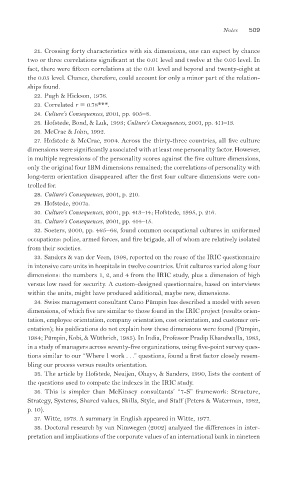Page 544 - Cultures and Organizations
P. 544
Notes 509
21. Crossing forty characteristics with six dimensions, one can expect by chance
two or three correlations significant at the 0.01 level and twelve at the 0.05 level. In
fact, there were fifteen correlations at the 0.01 level and beyond and twenty-eight at
the 0.05 level. Chance, therefore, could account for only a minor part of the relation-
ships found.
22. Pugh & Hickson, 1976.
23. Correlated r 0.78***.
24. Culture’s Consequences, 2001, pp. 405–8.
25. Hofstede, Bond, & Luk, 1993; Culture’s Consequences, 2001, pp. 411–13.
26. McCrae & John, 1992.
27. Hofstede & McCrae, 2004. Across the thirty-three countries, all fi ve culture
dimensions were significantly associated with at least one personality factor. However,
in multiple regressions of the personality scores against the five culture dimensions,
only the original four IBM dimensions remained; the correlations of personality with
long-term orientation disappeared after the first four culture dimensions were con-
trolled for.
28. Culture’s Consequences, 2001, p. 210.
29. Hofstede, 2007a.
30. Culture’s Consequences, 2001, pp. 413–14; Hofstede, 1995, p. 216.
31. Culture’s Consequences, 2001, pp. 414–15.
32. Soeters, 2000, pp. 465–66, found common occupational cultures in uniformed
occupations: police, armed forces, and fire brigade, all of whom are relatively isolated
from their societies.
33. Sanders & van der Veen, 1998, reported on the reuse of the IRIC questionnaire
in intensive care units in hospitals in twelve countries. Unit cultures varied along four
dimensions: the numbers 1, 2, and 4 from the IRIC study, plus a dimension of high
versus low need for security. A custom-designed questionnaire, based on interviews
within the units, might have produced additional, maybe new, dimensions.
34. Swiss management consultant Cuno Pümpin has described a model with seven
dimensions, of which five are similar to those found in the IRIC project (results orien-
tation, employee orientation, company orientation, cost orientation, and customer ori-
entation); his publications do not explain how these dimensions were found (Pümpin,
1984; Pümpin, Kobi, & Wüthrich, 1985). In India, Professor Pradip Khandwalla, 1985,
in a study of managers across seventy-five organizations, using five-point survey ques-
tions similar to our “Where I work . . .” questions, found a fi rst factor closely resem-
bling our process versus results orientation.
35. The article by Hofstede, Neuijen, Ohayv, & Sanders, 1990, lists the content of
the questions used to compute the indexes in the IRIC study.
36. This is simpler than McKinsey consultants’ “7-S” framework: Structure,
Strategy, Systems, Shared values, Skills, Style, and Staff (Peters & Waterman, 1982,
p. 10).
37. Witte, 1973. A summary in English appeared in Witte, 1977.
38. Doctoral research by van Nimwegen (2002) analyzed the differences in inter-
pretation and implications of the corporate values of an international bank in nineteen

